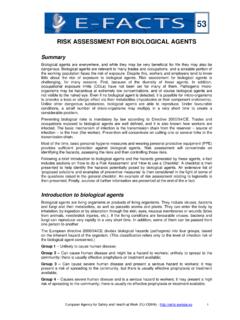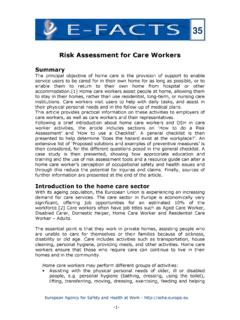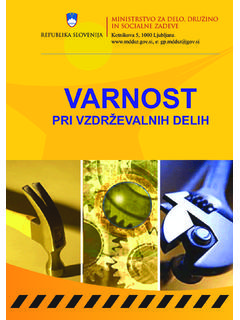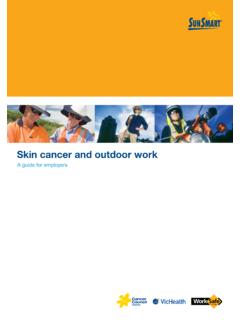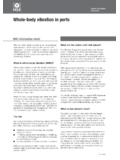Transcription of Musculoskeletal disorders in construction - Domov
1 1. Musculoskeletal disorders in construction construction is a high-risk sector, but it is not just a worker's safety at risk, but also his health. While there are well over a thousand workers killed each year in accidents in the construction sector, the re are also many more who suffer ill health. Musculoskeletal disorders are some of the most common forms of ill health in construction . Musculoskeletal disorders are particularly prevalent across a range of construction industry trades with estimates suggesting that as many as 30% of the workforce may be affected. Recent research has indicated that Musculoskeletal disorders are particularly prevalent in certain construction trades oroccupational groups such as bricklayers, plasterers and joiners.
2 Introduction What are work -related Musculoskeletal disorders ? work -related Musculoskeletal disorders (WMSDs) as defined by the International Commission on Occupational Health, are disorders and diseases of the Musculoskeletal system that have a causal determinant that is work - related. The term ` work related has been used by the World Health Organisation to specify a multi-factorial aetiology (scientific cause of a disease), where the performance of the work , and the work environment are two significant factors from a number that may contribute to the onset of the disease. There are a wide variety of WMSDs, from back injuries caused by the manual handling of heavy loads to wrist injuries caused by repetitive work .
3 What is the cost of WMSDs? The cost to the worker of WMSDs is pain, along with loss of income through being unable to work . This results in significant cost to organisations through sickness absence or ill-health retirement, and to the State, that may have to support a person unable to work . Legal duties All employers have legal duties to fulfil in their Member State, based upon European Directives, to prevent harm to workers. Perhaps the most important directives are: European Agency for Safety and Health at work - -1- Musculoskeletal disorders in construction 89/391/EEC - the "framework" directive - that sets out the basic requirements for workplaces.
4 90/269/EEC- the "manual handling" directive 92/57/EEC on the minimum health and safety requirements for temporary and mobile construction sites. Preventing WMSDs at the pre-build phase Architects and quantity surveyor s should be made aware of the potential improvements that can be introduced if manual handling methods are reviewed during the design phases of projects. Contractors, clients, and suppliers can encourage good practice standards to be fully implemented. Employers have legal duties to protect workers from WMSDs, based on European Directives. Where the risk of Musculoskeletal disorders cannot be designed out at the pre-build phase, then employers should carry out a risk assessment to identify the hazards, assess the risks, and take action to prevent ill health or injury.
5 Avoidance of manual handling The first consideration that needs to be made is can the manual handling activity be eliminated. There are many tasks in construction that can be avoided by mechanisation. Cranes, hoists, vacuum lifting devices, conveyor systems and other methods of mechanisations are always preferable to the task being carried out manually. Not only are there benefits for safety and health at work , but often productivity bonuses. Vacuum lifting devices are more efficient at carrying out slab and kerb laying than the manual task. The use of a crane on site enables it to be always available for use, such as taking delivery of materials.
6 However, the siting of the cranes is important to enable them to carry out this task efficiently, as is the suitability if the load for lifting by crane. Risk assessment It is most important that a suitable and sufficient assessment of the hazards and risks in the workplace is carried out to provide the basis for the introduction of improvements. Employers are required to evaluate risks to safety and health within their workplaces and then to improve the standards of safety and health for workers and others who may be harmed. This process is called a risk assessment. A risk assessment involves identifying the hazards present and then evaluating the extent of the risks involved.
7 The challenge is to eliminate, or European Agency for Safety and Health at work - -2- Musculoskeletal disorders in construction at least reduce, the potential for accidents, injury or ill health that arise from working activities and tasks. A good risk assessment, therefore, will form the basis for workplace changes to avoid accidents and ill health that can ruin lives, and for introducing measures that will help reduce the costs to businesses from lost output, compensation claims and higher insurance premiums. The person carrying out the assessment should have appropriate training and experience.
8 The complexity of the risk assessment will depend upon the size and type of site. Employers have a duty to cooperate to ensure that all workers are protected at work . There are several models for carrying out a risk assessment. Here is one step-by-step approach. 1. Look for the hazards Think about the work that is done and identify what may cause or increase the risk of work related Musculoskeletal disorders . For example: The handling of heavy materials;. Having to work on untidy, slippery, badly lit sites;. Having to carry out a lot of work reaching above the shoulder height Talk to the workers and their representatives.
9 Involve them in the risk assessment process and tell them what you are doing to reduce risk. 2. Decide who may be harmed and how. Think about everyone who may be hurt by each hazard. This means not just employees, but also contractors, self-employed persons, and members of the public. Specific attention should be paid to young workers and pregnant women. Consider how the dangers identified are going to cause harm. 3. Evaluate the risks and decide on action Evaluate the risk for each hazard, which means calculating the likelihood that any harm occurs and how severe it will probably be.
10 If someone could be hurt: Can the hazard be removed completely? Can the risk be controlled? Can protective measures be taken to protect the whole workforce? Is personal protective equipment needed to protect the worker from a risk that cannot be adequately controlled by collective preventive measures? European Agency for Safety and Health at work - -3- Musculoskeletal disorders in construction For example: Can building materials be supplied in smaller bags? Can mechanical handling aids be used to remove or reduc e the need to handle materials? Can the site be better maintained and kept clean and well lit to reduce the risk of minor accidents that lead to further ill health and injury?
